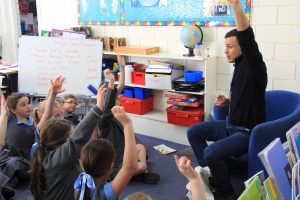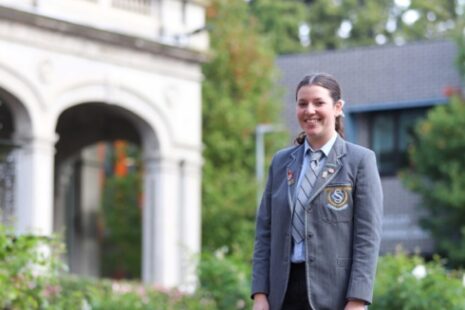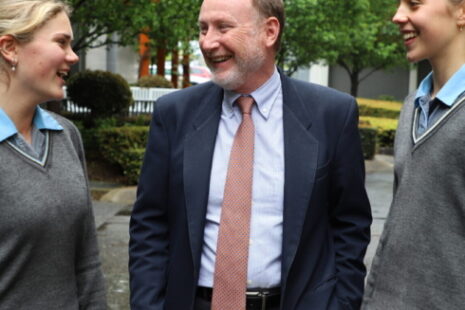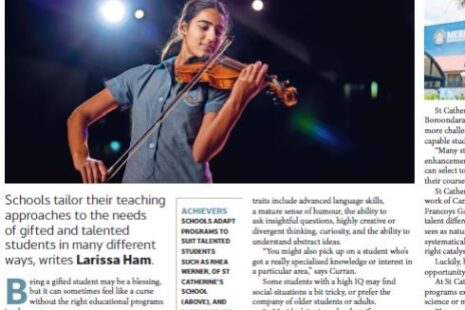Actions Speak Louder than Words

Reflections from a kinaesthetic language learning program, and why “Talking with our hands may actually make thinking easier”
During 2017 and now in 2018, our Junior School students in Barbreck have been speaking French with their hands. This is through the Accelerative Integrated Methodology, or ‘AIM’ program, a Canadian-developed program becoming ever more popular in French, Mandarin, Japanese and Spanish language classrooms across Australia. For the majority of our Junior School learners, their grip on the core fundamentals of critical fluency is tightening.
AIM, which now operates as the official leaning program for Years 1 to 6, is based upon principles of kinaesthetic learning, a concept popularised among education theory by Jean Piaget in the 1960s in his Theories of Cognitive Development. Piaget’s work discussed that, unlike the high levels of attention given to the principal learning styles of auditory and visual learners, the modern classroom often neglected the kinaesthetic learner, a student group containing up to 45% of the population (Spence, 2006).
Fast-forward to 2001, Susan Goldin-Meadow and three of her colleagues, conducted a study where participants where asked to remember a list of letters or words while explaining how to solve a Mathematics problem. Goldin-Meadow found participants who gestured while explaining could recall significantly more items than those who did not gesture.
This is where the AIM approach comes in, using high-frequency vocabulary, introduced with gestures and contextualised in stories, drama, songs and dance, allows students to achieve rapid levels of oral and written fluency in a short period of time (Maxwell, 2017). Similarly, the three key principles of the AIM kinaesthetic approach are creating change in the Barbreck French classroom, with an ever-growing community of learners sharing key language in impromptu, comfortable and meaningful ways.
Principle 1: Talking with our hands
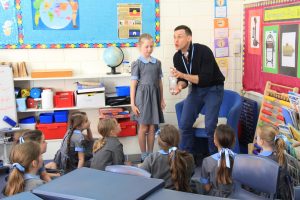
The AIM gesture-based language approach allows students to discuss, as a group, what we are doing and what we are supposed to be doing.
The gesture approach of the AIM methodology uses pared-down, key language and assigns a unique gesture to each word. Distilling the pool of classroom language to incorporate only high-frequency words (with a core focus on verbs) creates a more comfortable learning environment with lower levels of anxiety and, most importantly, less surprises for the learner (Maxwell, 2017).
Barbreck students are definitely speaking with their hands, and many seem to be enjoying it. Eye contact and focus is on the steep incline; if you don’t watch carefully you might miss the next action! I’ve noticed the gesture approach improve student communication in all the differentiated student groups; a Year 5 student who had never demonstrated clear comprehension is forming at least 3 independent sentences per class using gesturing. A Year 4 student who has demonstrated basic sentence formation is using actions to greatly refine and enrich her expression. And more proficient students? They tend to rely less on the actions and use them only to prompt themselves when discussing more complex ideas.
Principle 2: Parlons ensemble!
‘Parlons ensemble’ essentially translates to ‘let’s speak together!’. An AIM classroom is a ‘noisy but focused’ classroom; students are encouraged to speak at all times, in unison and using pared-down language in an expressive and impromptu manner. Beginning a lesson with structured whole-class activities involving continual verbal participation often leads to productive, spontaneous and authentic communication in smaller groups (Maxwell, 2017).
In Barbreck, French classes are beginning to feel more authentic rather than foreign or alien. The overwhelming majority of students move, look and listen with greater confidence than before. With the pared-down, gesture-based language we can finally discuss, as a group, what we are doing and what we are supposed to be doing. Are we opening or closing our books? Are we cutting with our glue sticks or gluing with our glue sticks? Do we eat bananas or write with bananas? Authentic response, and humour, is now more commonplace in the French classroom.
Principle 3: Encore, s’il vous plait!
AIM methodology is based around the examination of a core text (generally a French play) over a longer period of time (up to one semester). It encourages textual mastery rather than textual quantity and diversity, often contrasting with traditional language teaching approaches. The AIM educator does not say ‘you have understood the text, now read this one’; rather he or she will say ‘you have understood the text. Now, what else can you tell me about it?’ (Maxwell, 2017).
The introduction of the core AIM texts has been the biggest change in the Barbreck French classroom in 2018. The play La Poule Maboule (or Chicken Little) was introduced in 2018 in Year 1 and Year 2, Les Trois Petits Cochons (Two Little Pigs) in Years 3 and 4 and Comment Y Aller (How do we get there?) in Years 5 and 6. Verbal mastery of the play is the current objective, with students swiftly moving onto written tasks involving French grammar skills in mid-Term 1.
In conclusion, a kinaesthetic-based learning approach to language acquisition such as AIM is an exciting prospect for Barbreck. It is a classroom where authentic understanding and meaning is the norm rather than the exception. It is a classroom that moves with purpose and speed rather than ambling or dragging. I am excited to be part of this change.


